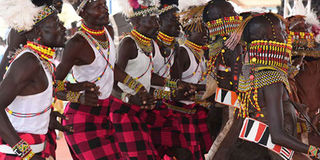What we have, what we do, what we are: My new look on culture

The Turkana Tourism and Cultural Festival is celebrated at Ekalees centre in Lodwar, Turkana County, on August 17, 2019. Culture includes all aspects of our lives. PHOTO | FILE | NATION MEDIA GROUP
As we land into mid-March, I would like to play the real scholar and give you a proper, analytical reflection, on culture. My meditation arose from three experiences that I have recently had in Nairobi, Eastern Kenya and in the Rift Valley.
The experiences have reminded me of my long-held belief that Kenya, and indeed the whole of modern Africa, cannot take off without a viable culture.
Let me start by telling you of my adventures. The first one is a book from my own “hometown” of Machakos. The second was a two-day international symposium in Nairobi on our cultural heritage.
INSPIRATION
The third experience, inevitably, is my observation of the ongoing (and often wrong-going or even non-going) BBI, whose strangeness struck me particularly on my brief visit to Eldoret-Kapsabet area.
The book from Machakos is called Fundamental Theories of Ethnic Conflict and it is edited by my friend and age-mate, Muli wa Kyendo, the journalist, novelist, dramatist and Founder Director of the Syokimau Cultural Centre.
The book comprises several in-depth papers by international experts in ethnology and conflict resolution.
The immediate inspiration for the book, as Muli points out in his moving Preface, was the infamous Kenyan post-election violence (PEV) of 2007 that left hundreds of people dead and many others displaced.
Muli says that he aims his book primarily at “policymakers, NGOs and others involved in creating peace”. But I think that it is a book that should be read by every thinking and caring mwananchi, especially as we move towards 2020. After all, who among us is not and should not be actively and passionately involved in peace building in our society?
RACIAL ENTITIES
More importantly for me, especially as I read between the lines of the text, was the suggestion that the basic root problem of Kenya’s social and political system is our failure to create a viable national culture out of our plethora of ethnic and racial entities.
As Muli, also an expert in oral communication and creativity, suggests in his main contribution to the book, our endless ethnic conflicts are grounded in our failure to understand and rise above our narrow, rigid ethnic inculcations towards a national multi-ethnic and inter-ethnic society.
Here, indeed, is where my second experience, in Nairobi, comes in. For two days, February 26 and 27 this year, a few scores of us culture buffs assembled at the grounds of the National Museums of Kenya to talk and share our favourite subject. This was at a get-together or symposium themed as “Culture Grows: Between Yesterday, Today and Tomorrow”.
Sponsored by the British Council and organised by the elite information management agency, Twaweza Communications, the symposium was a lively encounter between Kenyan culture professionals and practitioners and their counterparts from countries as diverse as Zimbabwe, South Africa, Britain, France, Switzerland and even as far away as Brazil and Indonesia.
UGANDAN MINORITIES
Uganda was, of course, represented but not by me. Their leader was my friend Emily Drani, co-founder and Deputy Director of the Cross-Cultural Foundation of Uganda (CCFU). The CCFU is in the forefront for the advocacy of the rights of the Maragolis and other Ugandan minorities, of whom we were talking the other day.
The presentations and interactions at the symposium were fascinating and stimulating. I would find it very difficult to say which were the best. But among my favourites were that of Harriet Chebet, a former London-based international banker, who is now in indigenous medicine, marketing her own herbal products under her own label.
This followed her being “cured” of periodical pains, which had plagued her for the better part of 20 years, with traditional herb popularly known among her people.
There was also the absolutely lovable Fardowsa Jama of the Awjama Cultural Centre in Nairobi’s Eastleigh area. I found her project of re-grounding the Kenyan Somali youth in the values of their community, as a way of giving them confidence and preparing them for sharing with other Kenyan youth, quite inspiring.
Such undertakings are a strong antidote to the isolation and stigmatisation to which some communities, like Fardowsa Jama’s, tend to be routinely subjected.
Anyway, these are only a few illustrations of how the theme of the symposium was brought to life for me. They further enlightened my conviction that culture is an all-embracing acquisition and process that establishes, sustains and develops societies. The key terms I noticed at the symposium were “heritage”, “creativity” and the strikingly long but relevant “inclusivity”.
REFLECTION
To put it radically, there is only culture. In other words, culture, in its basic, “Tabanic” sense of the way we live, defines and determines every moment and every aspect of our life. We do what we do because of who we are, where we are and what we want to be and where we want to go. I, for example, speak Kiswahili because I am an East African, living in East Africa, and I want to identify, share and co-operate with my fellow East Africans.
Culture is, thus, seen as “ungwana” (appropriateness) rather than “utamaduni” (city manners, from the Arabic “medina”, town). I have also heard some uncultured youth jeering at culture as “tamaa duni” (trashy desire). But that, I suppose, is just a reflection of their trashy lack of cultural education.
Prof Bukenya is a leading East African scholar of English and literature; [email protected]





